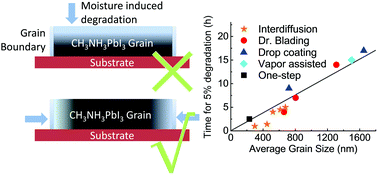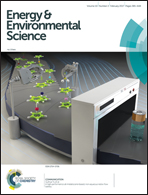Scaling behavior of moisture-induced grain degradation in polycrystalline hybrid perovskite thin films†
Abstract
The stability of perovskite solar cells has shown a huge variation with respect to the film process and film morphology, while the underlining mechanism for the morphology-dependent degradation of the perovskite film has remained elusive. Herein, we report a scaling behavior of moisture-induced grain degradation in polycrystalline CH3NH3PbI3 films. The degradation rates of CH3NH3PbI3 films in moisture were shown to be sensitive to the grain sizes. The duration that was needed for different films to degrade by the same percent showed a linear relationship with the grain size, despite the fact that the films were formed by five different deposition methods. This scaling behavior can be explained by the degradation along the in-plane direction, which is initiated at the grain boundary (GB). The GBs of CH3NH3PbI3 films consist of an amorphous intergranular layer, which allows quick diffusion of moisture into the perovskite films. It was found that thermal annealing induced surface self-passivation plays a critical role in stabilizing the surfaces of thin films and single crystals by reducing the moisture-sensitive methylammonium ions at the surface. The determination of the scaling behavior of grain degradation highlights the importance of stabilizing the GBs to improve the stability of perovskite solar cells.


 Please wait while we load your content...
Please wait while we load your content...